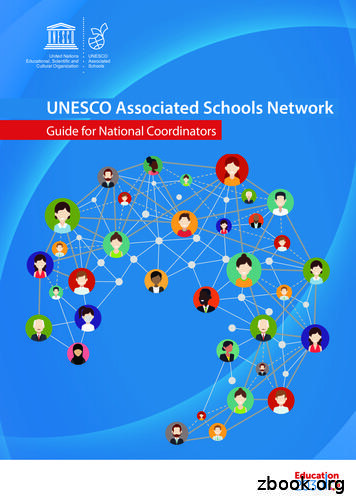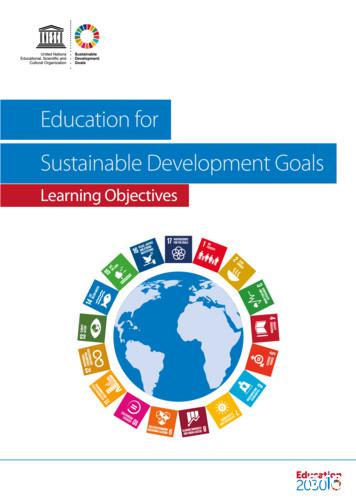School Gardens Manual - UNESCO
School Gardens ManualGuide on How to Plan, Establish &Maintain a School GardenSecond Edition, 2013Banjul, The G ambiaWith contributions from:SAFMU, NaNA, the Horticultural Department of the MoA & FIOH
SCHOOL GARDENS MANUALPAGE 2Table of ContentsF o rew o rd. . 4A ck nowledgements . 5Glossary of A cronyms . 6Why School Gardens? . 7Planning a School G arden . 8Who Will Be Involved? . 9What Will We Do?.10Who Will Do What?.11Making a Plan.12Sample Action Plan .13Sample Timeline .14Sample Weekly Work Schedule .14Where Can We Go for Help? .15Establishing a School Garden . 17Choosing a Site .18Garden Size .19Garden Lay-out .20Gardening Calenda r .21A Sample Garden Plan .22Live Fencing.22Garden Equipment and Tools.26Seedling Production . 27Seed Boxes .28Planting out .29Nursery managem ent .30Weeds & Pests .31Transplanting.31Maintaining the Garden . 32Tillage.33Spacing .33Watering Beds .33Manures.34Seed Collection and Sto rage . 35Compost-Making & Pest Control . . 37Compost-Making: Introduc tion .38Principles of Compos ting .38Composting Methods .40Pest Control: Agents Responsible for Crop Losses .43Managing Crop Losses .40
PAGE 1SCHOOL GARDENS MANUALPest Control Methods .41Organic Pesticides .46Nutrition, Health & Hygiene and School G ardens . 50Why is Nutrition Important? .51Which Nutrients are Important & Why? .53What Vegetables Should We Grow? .55A Healthy, Balanced Diet .56The Food Pyramid: A Guide to Good Eating.57Teaching Children about Nutrition .57Keeping Food Safe and Clean.58School Gardens & the E nvironment . 61Why is Preserving the Environment Important?.62What is Organic Farming? .62How Will Organic Farming Benefit the Environ m ent? .63Why is Organic Farming Beneficial in The Gambia? .63What Else Can I do? .64How to Recycle in the Garden .65R e co rd-Keeping . . 66Introduction .67Production and Financial Records .68Evaluation .71Reporting .72Using School Gardens as a Teaching Aid: Tips & Tricks . 73Closing Re marks . 78Annex I: Contact List . 79Annex II: Termly Reporting Format . . 80
SCHOOL GARDENS MANUALIntroductionPAGE 3
PAGE 4SCHOOL GARDENS MANUALAcknowledgementsThis manual has been developed by World Food Programme (WFP) The Gambia incollaboration with the School Agriculture and Food Management Unit (SAFMU) of theMinistry of Basic and Secondary Education, the Horticulture Department of the Ministryof Agriculture and the National Nutrition Agency. It also draws on the Gambian GardenManual developed by Peace Corps, The Gambia as well as input from volunteers.Resources on school gardening were shared from Concern Universal to aid in the latestedition of this manual. Many thanks are extended to these organizations for theirvaluable inputs.Gratitude is also extended to the Food and Agriculture Organization (FAO) and RuralFinance Project (RFP), who jointly implemented The National School Garden Programme(2010-2012). They provided valuable input during the planning and organization of thetraining and manual.Thank you to the schools included in the first two years of the school gardenprogramme. It has been a pleasure to work with and learn from you all.
SCHOOL GARDENS MANUALGlossary of AcronymsBCSBasic Cycle SchoolCMCluster MonitorECDCEarly Childhood Development CenterFAOFood and Agriculture Organization of the United NationsFFEFood for EducationFIOHFuture In Our HandsFMCFood Management CommitteeGoTGGovernment of the GambiaLBSLower Basic SchoolMDGMillennium Development GoalMoAMinistry of AgricultureMoBSEMinistry of Basic and Secondary EducationNaNANational Nutrition AgencyPTAParent Teacher AssociationREDRegional Educational DirectorateRFPRural Finance Project, Ministry of AgricultureSAFMUSchool Agriculture and Food Management Unit, Ministry of Basic andSecondary EducationSAUSchool Agriculture Unit, Ministry of Basic and Secondary EducationSFPSchool Feeding ProgrammeSMCSchool Management CommitteeWFPWorld Food ProgrammePAGE 6
PAGE 7WHY SCHOOL GARDENS?Why School Gardens?These are some of the benefits that establishing a school garden provides for theschool, the staff, students and community: Nutritional: improves children’s diet by supplementing school meals withvegetables and fruits that are rich in vitamins and minerals Educational: reinforces theory with practice by teaching children about foodproduction, natural resource management, health and nutrition, business skillsand entrepreneurship, and provides an outdoor space for teaching and learning. Environmental: improves the school environment while creating environmentalawareness and understanding Life Skills: children learn how to plan, make decisions, take responsibility andcollaborate with others Community: brings together the school and the community
SCHOOL GARDENS MANUALPlanning a School GardenPAGE 8
PAGE 9PLANNING A SCHOOL GARDENPlanning a School GardenWho Will Be Involved?Before starting work on the garden, establish who will be involved and what theirresponsibilities will be. The school should already have a School Managem entCommittee (SMC) and a Learner Welfare & School Environment sub-committee in place.One of this sub-committee’s key tasks is the management of the school feedingprogramme and the school garden or farm (see p. 42 of the SMC Manual, January 2008edition).The school Headmaster and Garden Master, if there already is one, should createenthusiasm for the project by sensitizing the community on the importance of schoolgardens as an educational tool and a nutritional supplement to WFP school meals. Thissensitization could be done as a school or in coordination with the local Ministry ofAgriculture and NaNA extension officers. Find individuals who are willing to commit timetowards the planning and execution of a garden.A Garden Master and Assistant Garden Master should be appointed. These should bepeople with some specialized knowledge of gardening and agriculture, and it isparticularly useful if he/she is also a ‘people person’ who can encourage people, adultsand children alike, to get excited about gardening.These are some other people who can be involved in making the garden a success: School Head Master Agricultural, Home Economics, Science or any other teachersSchool caretaker Members of the PTA, SMC, Food Management Committee (FMC), SchoolEnvironment & Learners’ Welfare Committee Members or Mothers’ ClubSchool cooks Village Alkalo / Imam Extension workers from the Ministry of Agriculture and Ministry of Forestry Students Parents and any other interested community members
SCHOOL GARDENS MANUALPAGE 10The more people that are involved, the less burden will fall on individuals. Getting thecommunity to participate is also important in ensuring that gardening knowledge andtraining gets shared. This will prevent knowledge from being lost when a staff memberleaves the school or community members move, thus ensuring the continuity andsustainability of the garden.What Will We Do?The Garden Master will have the most importantrole in planning, establishing and maintaining thegarden. He/she should establish what needs to bedone, delegate jobs and supervise the workconducted. However, there are also a multitude ofother things that can be done for, in and around thegarden. Here are some of the things that teachers,students, parents and community members can doto help make the garden a success: Organize community participation, a garden clean-up day or the sales of thegarden’s extra produce; Participate in deciding what the garden will look like, what vegetables will begrown and how the garden will be integrated into the curriculum as well as theschool meals; Build a garden shed, fence or wall;Demonstrate / Train people in gardening techniques, good nutrition or foodhygiene and preparation (this is particularly useful in rural areas where manyfamilies already farm and a good way for school cooks to be involved); Provide seeds, tools, manure, materials for the compost heap, sticks / poles forfencing, recipes, etc; Help with digging, weeding, watering, clearing land or tending to the gardenduring holidays; Encourage children and other community members to participate in gardeningactivities and teachers to use the garden as a learning center.
PAGE 11PLANNING A SCHOOL GARDENWho Will Do What?It is important to establish beforehand what everyone’s roles and responsibilities will be.Garden Masters cannot do all the work by themselves. Similarly, children can do manysmall chores in the garden, but they are not a labor force. Gardening should first andforemost be a fun learning activity, where children learn how to take on responsibilities,make decisions, plan, organize and collaborate. If gardening is seen as a punishment,the whole activity will defeat its purpose.Before starting, make a clear plan of who is responsible for what. There are many waysto go about this. Gardening can be done during class time or as an after school activity.Small groups of children can each tend to their own bed, or each grade can beresponsible for one activity, such as tilling, watering or weeding the garden.Responsibilities can be rotated on a monthly or termly basis so that everyone gets to dodifferent jobs and people do not get bored. Whatever the arrangement, make aschedule of activities and make sure people stick to it. It is particularly important thatthe garden does not get neglected during the holidays. Giving people incentives is agood way to make sure the work gets done (usually more so than giving outpunishments if they don’t). See Using a School Garden as Teaching Aid: Tips & Tricks,p. 74.)
SCHOOL GARDENS MANUALPAGE 12Making a Plan”He who fails to plan is planning to fail.” - Winston ChurchillInvolve as many people as possible right from the planning stage. If people take part inthe decision-making process it promotes ownership and people will be keener oninvesting time and energy in the garden. Brainstorm on: what the garden should look like, what will be grown,how it will be integrated into the curriculum and what will be done with the produce.It is a good idea to have a meeting to sensitize the community and involve them inplanning the garden.Once you’ve decided on the key issues, make an action plan, identifying the peopleresponsible and deadlines. This should include activities necessary for the establishmentof the garden, but can also include long-term goals such as when you foresee the firstharvest, or when you want to sell the first produce. Check your action plan often to assurethat your activities are on schedule and you don’t forget anything. Make several copies ofthe action plan. Keep one in the garden record book and post one on the wall in the headteacher’s office. Post others where they are visible and can serve as a reminder of tasks.Creating a timeline for larger events together with the children also teaches kids planningand gives them something to look forward to. Individual classes or smaller groups ofstudents can create a weekly or monthly work schedule to plan what needs to be done intheir own beds and in communal areas such as the nursery or compost heap.The following examples should serves as templates for the formatting of your action plan,timeline and work schedule. You should modify activities, persons responsible and theschedule to suit your school.
PAGE 13PLANNING A SCHOOL GARDENSample Action PlanActivityPersons ResponsibleDeadlineDecide on a variety ofvegetables to grow in gardenGarden Master, School Cooks, GardenClub10 September2013Create map of garden lay-outGarden Master, Agricultural Sciencesteacher, Grade 5 students12 September2013Organize a teacher workHead Master, Garden Master, teacherssession to cooperate on making for all grade 1-6 classes, Agriculturallesson plans that incorpora teSciences, Science & Maths teachersthe garden into the curriculum26 September2013Inspect and repair fence around Garden Master, community membersgarden1 October 2013Prepare seedboxesAgricultural Sciences teacher, Grades 341 October 2013Prepare nursery bedsAgricultural Sciences teacher, Grade 63 October 2013Water nursery bed dailyGrade 5 students1 October 2013until outplantingBring materials for compostheapAll children, community members4 October 2013Start compost heapAgricultural Sciences teacher, Ministry of 6 October 2013Agriculture Extension Worker, grade 6studentsRemove weeds from nurserybedGarden master, grade 3 students8 October 2013Planting of seeds in seedboxes& nurseryGarden Master, Grades 3-49 October 2013
2013ActionSepOctN ov2014DecJanF ebM arAprM ayJunJulAugSepF encing GardenPreparation ofSeedbox & NurseryPreparation ofGarden BedsSCHOOL GARDENS MANUALSample TimelineC om postingHarvestingSeed collectionSales of ProduceSample Weekly Work ScheduleW eekly Work Schedule Green Team, Grade 6W eek: April 14-18, 2014M ondayGardeningWatering Lam inC hecking &RecordingMeasure PlantGrowth - AliC o m m un a lW o rkW ednesdayThursdayF ridayWatering &Spraying Neem- Binta & IsatouPreparingneem pesticide– Bak ary & AmiWatering &Weeding M om odou & AliSaturdaySundayCheck forPests - BintaWrite Report Binta & AliFix Fence M om odou &IsatouTurn Compost Lam inClass Display onGarden Bugs &Insects - AllPAGE 14C lass WorkTuesday
PAGE 15PLANNING A SCHOOL GARDENWhere Can We Go for Help?When it comes to gardening, you are not alone! There are a multitude of people andinstitutions you can contact for tips, advice or if you’ve encountered some problemsalong the way. School Staff: agricultural science, math, home economics and business studiesteachers are an easy first point of reference for any issues pertaining togardening, nutrition, food hygiene, preparation and conservation, marketingsales and accounting. School caretakers usually know more about the schoolenvironment than any other school staff and have lots of practical know-how. Home gardens near the school: identify well-managed home and communtiygardens near the school and ask the owners for help. They will
responsibilities will be. The school should already have a School Management Committee (SMC) and a Learner Welfare & School Environment sub-committee in place. One of this sub-committee’s key tasks is the management of the school feeding programme and the school garden or farm (see p. 42 of the SMC Manual, January 2008 edition).
The UNESCO -IHE Institute for Water Education (UNESCO -IHE) became part of the UNESCO Water Familyduring the 31 st session of the UNESCO General Conference in October 2001 and started its operations in June 2003. Before becoming a UNESCO Category I Institute, UNESCO -IHE
UNESCO Office, Jakarta Publications 2006-2007 UNESCO Office, Jakarta www.UNESCO.or.id Jl. Galuh II no 5. Kebayoran Baru. Jakarta 12110 Tel: 62-21 7399818. Fax: 62-21 72796489 Email: Jakarta@unesco.org UNESCO Librarian : Rosinta P. Hutauruk (rp.hutauruk@unesco.org ) Basic Sciences (BSC) -2007 / 2006 Coastal and Small Island -2007 / 2006
4 Resolution 1.341, 7th session of the UNESCO General Conference, 1952 5 Document UNESCO/ED/149 of 4 February 1957 6 Document ED/MD/19, 1971 7 UNESCO's Associated Schools Project Network (ASPnet) - List of Participating Institutions, UNESCO 1997 8 Approved Programme and Budget for 1998-1999, Document 29 C/5, Paragraph 06028, UNESCO, 1998 1 1
Garden (now Hershey Gardens). Milton and Kitty Hershey with friends in High Point gardens, ca. 1911. Henry Hohman visited Hershey Gardens in 1971. He donated more than 400 varieties of conifers, Boxwoods, Hollies and other ever-green plants to Hershey Gardens, in 1967. During the 1950s and 1960s, Hershey . Gardens expanded with the addition of
Botanical Gardens at Sanibel Sanibel, FL 33957 (239) 472-4119 The Cummer Museum of Art & Gardens-6857 museum.org Fort Myers, FL 33901 (239) 334-7419 Everglades Wonder Gardens 27180 Old 41 Road Bonita Springs, FL 34135 (239) 992-2591 10901 Old Cutler Road (305) 667-1651 www.fairchildgarden.org Flamingo Gardens-2955 The Florida Botanical Gardens
Botanical Gardens and two areas of open parkland now known as the North and South Gardens. The Botanical Gardens Nursery was established in 1859. Plants and seeds were received from the Royal Melbourne and Geelong Botanic Gardens. In the 1860s, the principal tree planting began while in 1888 a maze was built in the North Gardens to the same .
Designed and printed by UNESCO Printed in France UNESCO Education Sector Education is UNESCO’s top priority because it is a basic human right and the foundation on which to build peace and drive sustainable development. UNESCO is the United Nations’ specialized agency for education and the Education Sector provides global and
This brochure was prepared collaboratively by colleagues from the UNESCO Education Sector, including from the Regional bureaux (Bangkok, Beirut, Dakar and Santiago) and the following institutes: UNESCO International Bureau of Education, UNESCO International Institute for Educational Planning, UNESCO























